![]()
![]()
![]()
Use LEFT and RIGHT arrow keys to navigate between flashcards;
Use UP and DOWN arrow keys to flip the card;
H to show hint;
A reads text to speech;
17 Cards in this Set
- Front
- Back
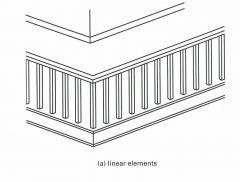
DESIGN ELEMENTS - FORM
|
elements of design-
form- LINEAR ELEMENTS the balusters of the railing appear as linear elements due to length exceeding width and depth |
|
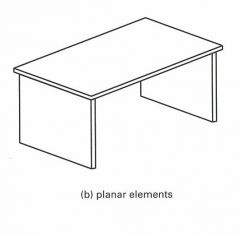
DESIGN ELEMENTS - FORM
|
elements of design-
form- PLANAR ELEMENTS two dominant dimensions: 1. length 2. width |
|
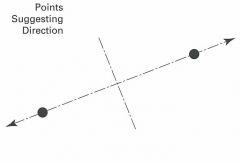
DESIGN ELEMENTS - FORM
|
elements of design-
form- POINTS SUGGESTING DIRECTION two points create an implied line of direction between them therefore, they also create a line (also implied) which runs perpendicular to the connecting line |
|

DESIGN ELEMENTS - FORM
|
elements of design-
form- POINTS ON A PLANE a. static - line similar to gestalt grouping b. dynamic - energizes the plane |
|
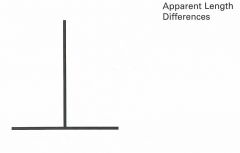
DESINE ELEMENTS - FORM
|
elements of design-
form- LINES can affect perception |
|
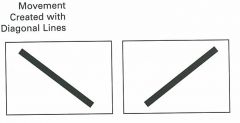
DESIGN ELEMENTS - FORM
|
elements of design-
form- DIAGONAL LINES create movement |
|
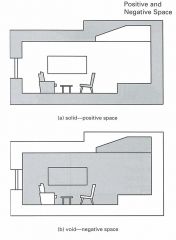
DESIGN ELEMENTS - FORM
|
elements of design-
form- VOLUME a. solid - has mass and occupies space b. void - space as defined by planes or other elements |
|
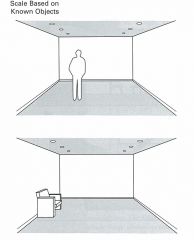
DESIGN ELEMENTS - SCALE
|
elements of design-
scale- based on KNOWN OBJECTS the human body is best example |
|
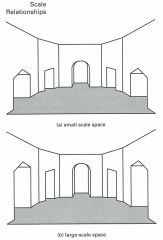
DESIGN ELEMENTS - SCALE
|
elements of design-
scale- based on RELATIONSHIPS the smaller openings at top create larger room than larger openings below the actual size of the space is unknown, as there is no comparison to a known object |
|
|
color facts:
1. wavelength - longest / shortest 2. additive colors 3. subtractive colors 4. primary colors of light 5. primary colors of pigment 6. hue 7. value 8. intensity (chroma) 9. tint 10. shade 11. tone |
color facts:
1. colors are differentiated by their wavelengths; red has the longest, violet the shortest 2. additive colors are created with light; when all colors of light are present it creates white 3. subtractive colors are created with pigment; when all colors of a pigment are present it creates black 4. the primary colors of light are: green, red & blue 5. the primary colors of pigment are: red, blue & yellow 6. hue is the basic color 7. value is the value lightness or darkness when the color is compared to white or black 8. intensity (chroma) is the degree of purity when compared to a neutral gray of the same value 9. tint is created when white is added to a hue 10. shade is created when black is added to a hue 11. tone is created by adding gray to a hue |
|
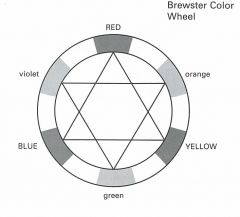
DESIGN ELEMENTS - COLOR
|
elements of design-
color- BREWSTER (PRANG) COLOR SYSTEM color wheel |
|
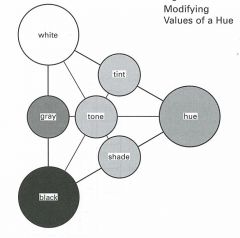
DESIGN ELEMENTS - COLOR
|
elements of design-
color- QUALITIES OF COLOR modifying the values of a hue hue + white = tint hue + gray = tone hue + black = shade |
|
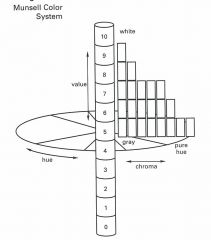
DESIGN ELEMENTS - COLOR
|
elements of design-
color- MUNSELL COLOR SYSTEM three scales in three dimensions to specify hue, value and intensity (chroma) |
|
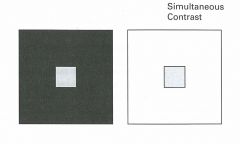
DESIGN ELEMENTS - COLOR
|
elements of design-
color- EFFECTS OF ADJACENT COLORS & LIGHT shown is "simultaneous contrast" -a light color on dark appears lighter -a light color on a lighter background appears darker |
|
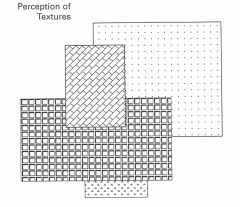
DESIGN ELEMENTS - TEXTURE
|
elements of design-
texture- TEXTURE PERCEPTION changes when compared to other textures |
|
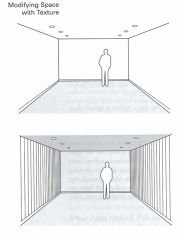
DESIGN ELEMENTS - TEXTURE
|
elements of design-
texture- MODIFYING SPACE texture can bring surfaces closer, such as the walls in a large room texture can also provide emphasis or focus to one part of a space |
|
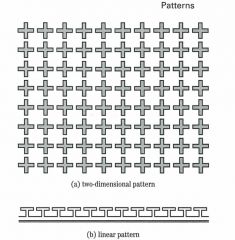
DESIGN ELEMENTS - PATTERN
|
elements of design-
pattern- DECORATIVE MOTIF ON A SURFACE a. two-dimensional pattern b. linear pattern |

